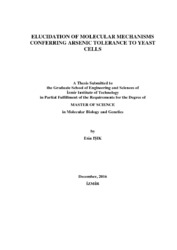Please use this identifier to cite or link to this item:
https://hdl.handle.net/11147/5739Full metadata record
| DC Field | Value | Language |
|---|---|---|
| dc.contributor.advisor | Karakaya, Hüseyin Çağlar | en_US |
| dc.contributor.author | Işık, Esin | - |
| dc.date.accessioned | 2017-06-12T09:03:45Z | - |
| dc.date.available | 2017-06-12T09:03:45Z | - |
| dc.date.issued | 2016-12 | - |
| dc.identifier.citation | Işık, E. (2016). Elucidation of molecular mechanisms conferring arsenic tolerance to yeast cells. Unpublished master's thesis, İzmir Institute of Technology, İzmir, Turkey | en_US |
| dc.identifier.uri | http://hdl.handle.net/11147/5739 | - |
| dc.description | Thesis (Master)--Izmir Institute of Technology, Molecular Biology and Genetics, Izmir, 2016 | en_US |
| dc.description | Full text release delayed at author's request until 2019.12.16 | en_US |
| dc.description | Includes bibliographical references (leaves: 53-64) | - |
| dc.description | Text in English; Abstract: Turkish and English | en_US |
| dc.description | xiii, 64 leaves | - |
| dc.description.abstract | Arsenic is a highly toxic metalloid available in the environment mainly as arsenite or arsenate. These compounds’ interference with many molecular mechanisms results in several diseases including cancer. Conversely, arsenic is used in therapeutic approaches, however, they are associated with drug resistance. Although some tolerance and toxicity mechanisms of arsenicals in yeast have been enlightened by previous studies, complete understanding, which is important for development of protection and therapy strategies, has not yet been achieved. Comprehensive genome-wide screening is a promising approach for the elucidation of novel genes involved in arsenic-associated mechanisms. The aim in this study was to screen a yeast genome library to characterize novel genes whose overexpression confers resistance to toxic concentrations of arsenate or arsenite in Saccharomyces cerevisiae. The plasmids from the colonies confirmed to be highly-resistant against arsenicals were sequenced to determine the genomic regions and seven genes were selected to clone into expression vectors. The overexpression of Pho86p and Vba3p provided yeast cells with the highest arsenate and arsenite resistance, respectively. Arsenate is a phosphate analogue and taken up by phosphate transporters. Pho86p is an ER-resident protein regulating ER-exit of the phosphate transporter. Therefore, it is reasonable that overexpression of Pho86p provides arsenate resistance. Vacuolar sequestration is a common route for the removal of toxic compounds from the cytosol and Vba3p is a vacuole-located transporter of basic amino acids with a likely role in arsenite resistance. Consequently, the screen in the current study revealed two genes with promising roles for tolerance mechanisms against arsenicals. | en_US |
| dc.description.abstract | Arsenik doğada genellikle arsenit veya arsenat formlarında bulunan oldukça toksik bir metaloiddir. Bir yandan, birçok moleküler mekanizmayı etkileyerek, kanser de dahil olmak üzere çeşitli hastalıklara yol açarken, diğer taraftan bazı ilaçların içerisinde terapitik ajan olarak kullanılmaktadır. Fakat kanser hücreleri bu ilaçlara karşı direnç geliştirmektedirler. Şimdiye kadar yapılmış çalışmalar, arsenik dirençliliği ve toksisitesinin bazı yönlerini aydınlatmış olsa da, henüz tam bir anlayışa ulaşılamamıştır. Bu mekanizmaların her yönüyle anlaşılması, arsenikten korunma veya arseniği tedavilerde kullanabilme açısından çok önemlidir. Bu anlaşılmada, genom düzeyindeki taramalar umut vaadeden yaklaşımlardır. Bu çalışma, maya genom kütüphanesini tarayarak, yüksek ekpresyonu, toksik arsenik konsantrasyonuna direnç kazandıran genleri tayin etmeyi amaçlamıştır. Dirençli olduğu kanıtlanmış kolonilerden elde edilen plasmidler, plasmidlerdeki genomik bölgeleri belirlemek için sekanslanmış ve bu bölgelerdeki genlerin bir kısmı ekspresyon vektörlerine klonlamak için seçilmiştir. Seçilen yedi gen arasında, PHO86’nın arsenata, VBA3’ün ise arsenite oldukça dirençli olduğu görülmüştür. Arsenat bir fosfat analoğu olduğundan, ER’dan çıkışı Pho86 proteini tarafından yönetilen fosfat taşıyıcı proteininden faydalanarak hücre içine girmektedir. Dolayısıyla, PHO86 geninin yüksek ekpresyonunun direnç kazandırması mümkündür. Koful, toksik maddelerin sitozolden uzaklaştırılması için kullanılan bir organeldir ve VBA3 de kofulda bulunan ve bazik aminoasitleri kofula taşıyan bir taşıyıcı proteindir. Bilinen bu fonksiyonu, Vba3 proteininin dirençlilik mekanizmasında rol oynayabileceğine işaret eder. Sonuç olarak, yapılan bu tarama, arsenik dirençlilik mekanizmaları ile ilgili olabilecek ve umut vaat eden iki tane geni tayin etmiştir. | en_US |
| dc.language.iso | en | en_US |
| dc.publisher | Izmir Institute of Technology | en_US |
| dc.rights | info:eu-repo/semantics/openAccess | en_US |
| dc.subject | Saccharomyces cerevisiae | en_US |
| dc.subject | Arsenic | en_US |
| dc.subject | Yeast cell | en_US |
| dc.subject | Molecular mechanism | en_US |
| dc.subject | Toxicity | en_US |
| dc.title | Elucidation of molecular mechanisms conferring arsenic tolerance to yeast cells | en_US |
| dc.title.alternative | Maya hücrelerine arsenik dirençliliği kazandıran moleküler mekanizmaların aydınlatılması | en_US |
| dc.type | Master Thesis | en_US |
| dc.institutionauthor | Işık, Esin | - |
| dc.department | Thesis (Master)--İzmir Institute of Technology, Molecular Biology and Genetics | en_US |
| dc.request.email | esin.eska@gmail.com | - |
| dc.request.fullname | Esin Işık | - |
| dc.relation.publicationcategory | Tez | en_US |
| item.openairetype | Master Thesis | - |
| item.fulltext | With Fulltext | - |
| item.openairecristype | http://purl.org/coar/resource_type/c_18cf | - |
| item.grantfulltext | open | - |
| item.cerifentitytype | Publications | - |
| item.languageiso639-1 | en | - |
| Appears in Collections: | Master Degree / Yüksek Lisans Tezleri Sürdürülebilir Yeşil Kampüs Koleksiyonu / Sustainable Green Campus Collection | |
Files in This Item:
| File | Description | Size | Format | |
|---|---|---|---|---|
| T001549.pdf | MasterThesis | 2.59 MB | Adobe PDF |  View/Open |
CORE Recommender
Page view(s)
130
checked on Jul 22, 2024
Download(s)
60
checked on Jul 22, 2024
Google ScholarTM
Check
Items in GCRIS Repository are protected by copyright, with all rights reserved, unless otherwise indicated.